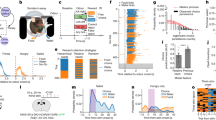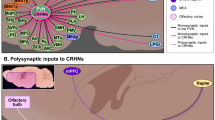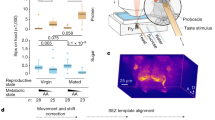Abstract
A HUNGRY animal is considered to be in a state of high nervous irritability leading to a heightened level of sensory and motor excitation. As glycogen stores are depleted, blood glucose-levels decrease, circulating epinephrine rises and stimulates the reticular formation of the brain, which in turn produces cortical arousal and facilitation of motor and sensory activity, lowering the threshold for all external sensory stimuli1. A satiated animal, by contrast, is relaxed, disinterested in the outside world, sleepy, and consequently should have a high sensory threshold.
This is a preview of subscription content, access via your institution
Access options
Subscribe to this journal
Receive 51 print issues and online access
$199.00 per year
only $3.90 per issue
Buy this article
- Purchase on SpringerLink
- Instant access to full article PDF
Prices may be subject to local taxes which are calculated during checkout
Similar content being viewed by others
References
Dell, P. C., Neurological Basis of Behavior, 187 (Ciba Symposium, 1958).
Goetzl, F. R., and Stone, F., Gastroenterol., 9, 444 (1947). Goetzl, F. R., Goldschmidt, M., Wheeler, P., and Stone, F., ibid., 12, 252 (1949). Goetzl, F. R., Abel, M. S., and Ahokas, A. J., J. App. Physiol., 2, 553 (1950). Goetzl, F. R., Ahokas, A. J., and Goldschmidt, M., ibid., 4, 30 (1951).
Janowitz, H. D., and Grossman, M. I., J. App. Physiol., 2, 217 (1949).
Hammer, F. J., J. Comp. and Physiol. Psychol., 44, 403 (1951). Schneider, R. A., and Wolf, S., J. App. Physiol., 8, 337 (1955). Fruchtgott, E., and Friedman, M. P., J. Comp. and Physiol. Psychol., 53, 576 (1960).
Ough, C. S., and Stone, H., J. Food Sci., 26, 452 (1961).
Author information
Authors and Affiliations
Rights and permissions
About this article
Cite this article
BERG, H., PANGBORN, R., ROESSLER, E. et al. Influence of Hunger on Olfactory Acuity. Nature 197, 108 (1963). https://doi.org/10.1038/197108a0
Issue date:
DOI: https://doi.org/10.1038/197108a0



